by Dean Kallas, Grocery Category Manager
Chocolate has come a long way since I was young, or maybe my taste buds have changed. I remember when you could get a decent-sized candy bar for a dime. And then they kept getting smaller and more expensive. There were no chocolatiers in the city I grew up in. The only dark chocolate was the major brand bar with 45% cacao.
So what does good chocolate taste like? Many believe it is up to the individual to decide for themselves. Although I tend to agree with this sentiment, having a greater knowledge of chocolate and its components is important in choosing your favorite.
Where Does All That Flavor Come From?
The flavor notes that come through when you pop some chocolate in your mouth result from several factors: the soil the cacao beans are grown in, the methods used to ferment these beans after harvest, and the expertise used by the chocolatiers when creating the final product. There are three varieties of cacao and each has unique characteristics. The type of sweetener and the amount used also influence the outcome. Other ingredients can overshadow the true flavor of the chocolate.
For example, many people prefer milk chocolate to dark chocolate, but milk itself diminishes the chocolate’s strength. Caramel is another overpowering flavor. Coffee, pieces of fruit, or mint can dominate as well. We all have different favorites, but when it comes to trying chocolate, some of these get in the way.
Setup for Tasting
Make sure the chocolate is at room temperature before you start. Ideally it is better to not refrigerate your chocolate at all unless it is raw. Store it in a cool, dry place. It is useful to have a palate cleanser on hand to neutralize the flavor of the bar you just finished, so you can move on to the next one. I like using spring water as my cleanser.
For a true chocolate tasting, do not serve other food or wine, as these will interfere. Some connoisseurs like to taste wine and chocolate combinations, but that is a subject for another time.
How to Taste Chocolate
If you have quite a few bars you want to try, it is better to start out with those that have a lower percentage of cacao in them and work your way up to the darker chocolate. More intense flavor tends to come through with the darker varieties, and it is best to start simple and get more complex.
Begin by giving each chocolate a good smell before you taste it to note its aromas. Smell is a major component of taste. I was at an olive oil tasting a number of years ago, and the trainer literally had us hold our nose so we could not smell. It was an educational moment, because not being able to smell made it very difficult to taste.
After you have given your bar a good smell, take a look at the chocolate. If it is pale or has a whitish coating it is not of good quality. Hopefully it is shiny and when you break it apart it makes a good snapping sound. Now place a small piece in your mouth, but do not chew it. Let it slowly melt in the center of your tongue so its flavor can come through. Note the mouthfeel. Is it creamy? Is it dry? Is it coarse or smooth?
What do you taste? Is it acidic with fruity notes or more vinegary? How bitter is it? How sour? There are many flavor notes that you might detect, such as: cocoa, sweetness, dried fruit, fresh fruit, nuttiness, floral notes, and spices. There may be an aftertaste. If you notice defective flavors, this is a sign that the chocolate has deteriorated or been contaminated somewhere along its journey.
Tasting Notes and Chocolate Bars to Try
For my tasting, I chose chocolate bars in the 70% cacao range because I find they have just enough sweetness but without any milk content. All of these bars are carried at each of our stores. They are not the bars of my childhood. If you are a chocolate lover like me, I think you will like these too.
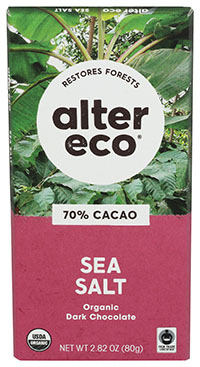 Alter Eco Dark Chocolate with Sea Salt
Alter Eco Dark Chocolate with Sea Salt
Price: $3.99
Size: 2.8 oz
Fair Trade? Yes
Vegan? Yes
Cacao percentage: 70%
Cacao origin: Ecuador
Tasting Notes: Smooth, cocoa flavor with sweet notes, dried fruit.
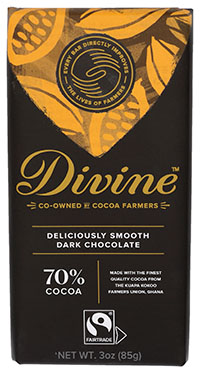 Divine Dark Chocolate
Divine Dark Chocolate
Price: $3.99
Size: 3 oz
Fair Trade? Yes
Vegan? Yes
Cacao percentage: 70%
Cacao origin: Ghana
Tasting Notes: Strong cacao flavor.
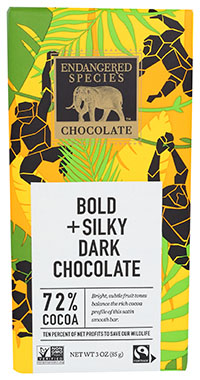 Endangered Species Chocolate Bold + Silky Dark Chocolate
Endangered Species Chocolate Bold + Silky Dark Chocolate
Price: $3.29
Size: 3 oz
Fair Trade? Yes
Vegan? Yes
Cacao percentage: 72%
Cacao origin: Unknown
Tasting Notes: Bitter at first, giving way to slightly sweet fruity finish.
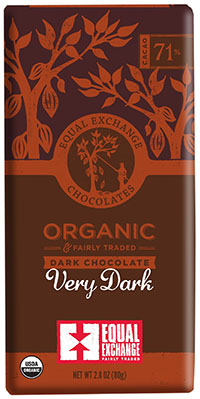 Equal Exchange Very Dark Chocolate
Equal Exchange Very Dark Chocolate
Price: $3.49
Size: 2.8 oz
Fair Trade? Yes
Vegan? Yes
Cacao percentage: 71%
Cacao origin: Dominican Republic and Peru
Tasting Notes: Rich, fudgy, with hints of fruit and a sweet finish.
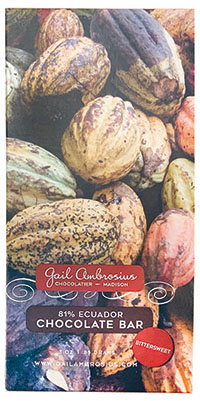 Gail Ambrosius Bittersweet Bar
Gail Ambrosius Bittersweet Bar
Price: $5.75
Size: 3 oz
Fair Trade? No
Vegan? Yes
Cacao percentage: 81%
Cacao origin: Ecuador
Tasting Notes: Smooth, velvety texture, subtle citrus notes.
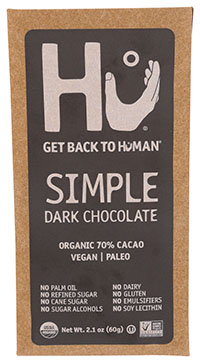 Hu Simple Dark Chocolate
Hu Simple Dark Chocolate
Price: $5.29
Size: 2.1 oz
Fair Trade? Yes
Vegan? Yes
Cacao percentage: 70%
Cacao origin: Unknown
Tasting Notes: Sweet, coarse, strong cacao taste.
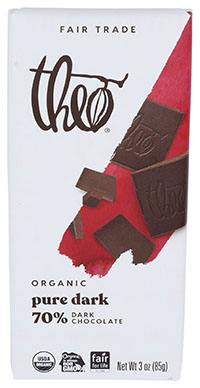 Theo Chocolate Pure Dark
Theo Chocolate Pure Dark
Price: $3.79
Size: 3 oz
Fair Trade? Yes
Vegan? Yes
Cacao percentage: 70%
Cacao origin: Democratic Republic of the Congo
Tasting Notes: Smooth, slightly sweet, vanilla, slow melting.
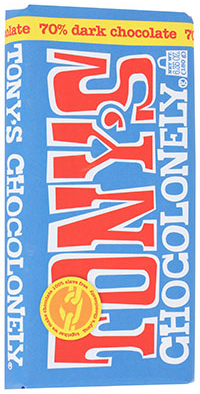 Tony’s Chocolonely Dark Chocolate
Tony’s Chocolonely Dark Chocolate
Price: $4.99
Size: 6.35 oz
Fair Trade? Yes
Vegan? Yes
Cacao percentage: 70%
Cacao origin: Ivory Coast and Ghana
Tasting Notes: Smooth, hints of banana.
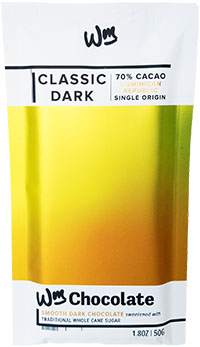 Wm. Chocolate Classic Dark
Wm. Chocolate Classic Dark
Price: $4.99
Size: 1.8 oz
Fair Trade? No
Vegan? Yes
Cacao percentage: 70%
Cacao origin: Dominican Republic
Tasting Notes: Smooth, dried fruit and floral.









